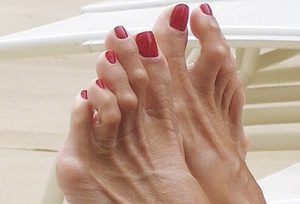Do you have a Bunion that needs checking?
Have you developed a bump on the big toe joint? Are you getting pain in your big toe joint? You may be asking yourself – Do I have a bunion?
What is that bump on the big toe joint? Is it a bunion?
 A bunion is a deformity of the big toe joint. The technical name is Hallux Abducto Valgus. In simple terms this describes the deviation of the big toe towards the smaller toes (toes 2-5).
A bunion is a deformity of the big toe joint. The technical name is Hallux Abducto Valgus. In simple terms this describes the deviation of the big toe towards the smaller toes (toes 2-5).
In many cases, a bunion is a progressive deformity that gets worse over time. As the bunion gets worse a bump on the big toe joint may develop. Also the skin can become reddened, swollen and painful and osteoarthritic changes to the joint can occur.
Over time the bump on the big toe joint can make shoe fitting increasingly difficult and can further contribute to pain. A bunion can also make you feel embarrassed about your feet.
What causes a bunion?
Bunions are cause by a combination of family genetics, shoes, physical activities and foot alignment. You can read more about why you can get bunions in our article “How come my feet have developed bunions?”
How can we help your bunion?
Foot Mobilisation Therapy (FMT) and corrective exercises help to realign the big toe and correct the structure of the foot. This can reduce the pain and discomfort and stop the bunion from becoming worse, especially with early treatment.
Mobilising the big toe joint also increases the production of synovial fluid helping the joint to work more efficiently, with less pain. Additionally this decreases the risk of osteoarthritis within the joint.
Unfortunately only surgery can remove the bump on the big toe joint. This is where a detailed assessment of your goals and situation allows us to make the best treatment recommendation for you.
Should I have surgery?
Surgery can be effective at addressing the cosmetic appearance of the bunion by removing the bone. Before making a decision you need to be weigh your individual goals, pain level and risks of the procedure. Things to consider are: time for recovery and time off work, pain, infection and other complications. Discussing this with an orthopaedic or podiatric surgeon is the best option to make an informed surgical decision.
Remember, having your foot function checked is strongly recommended irrespective if you have surgery or not.
If you fail to address the underlying drivers of your bunion development your bunion can redevelop over time – remember treat the cause not just the symptoms.
When the bunion is identified and treated early surgery can often be avoided.
What are Hammer Toes and Claw Toes?
 Hammer or claw toes are where the toe bends excessively in the middle joints resulting in a deviated shape and alignment leading to a claw or hammer appearance.
Hammer or claw toes are where the toe bends excessively in the middle joints resulting in a deviated shape and alignment leading to a claw or hammer appearance.
What causes hammer toes?
Causes of hammer toes include inherited foot types, poor foot bio-mechanics and function causing contraction of muscles and ligaments making flattening and extending of the toes difficult. Some arthritic conditions such as rheumatoid arthritis can also cause bone changes over time.
How can we help Hammer Toes?
The clawing and hammer toe positions are treated using strengthening, stabilising and stretching exercises and Foot Mobilisation Therapy (FMT). This helps shoe fit, comfort and function. In advanced cases surgery may be indicated.




